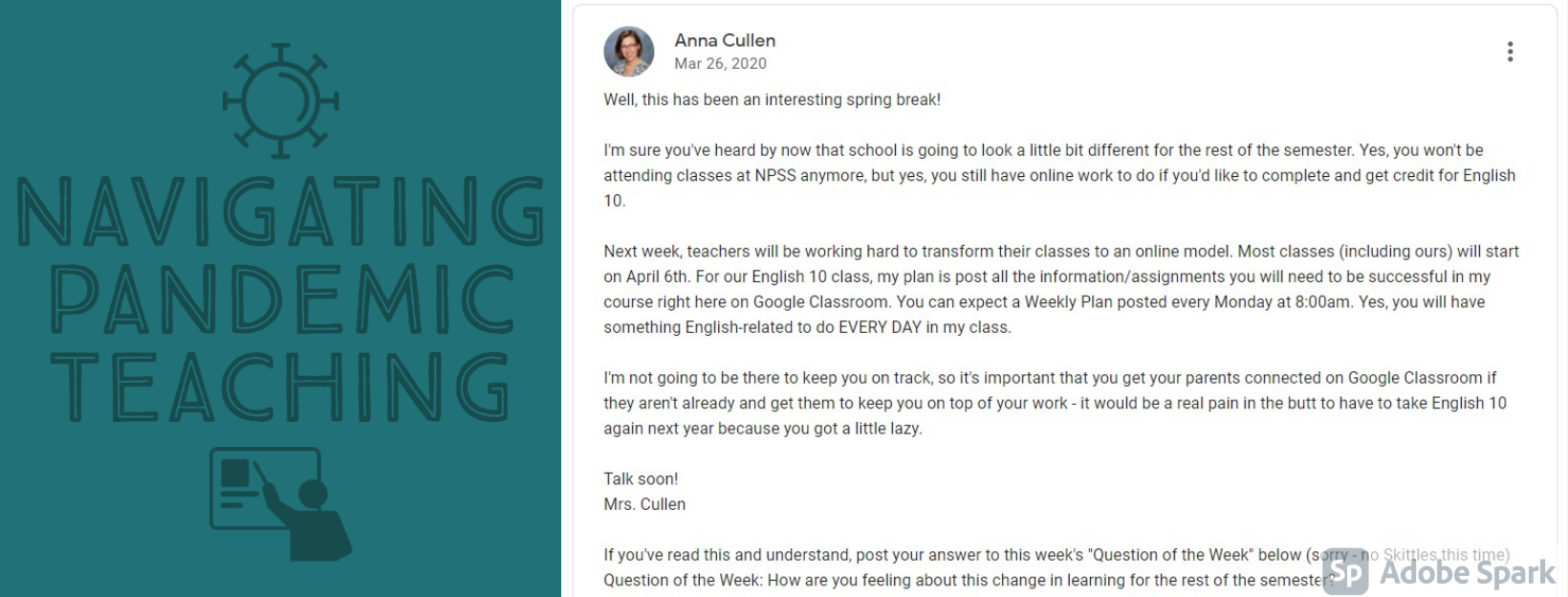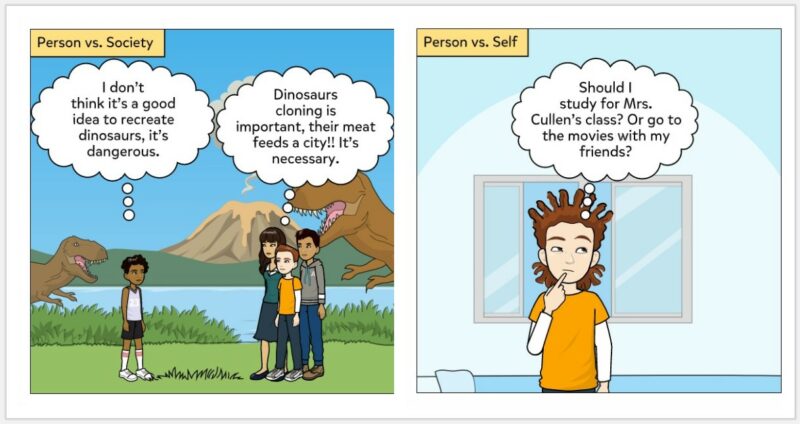For my blog post this week, I want to reflect on an English 10 class that I taught in Spring 2020. The course followed the BC Curricular Documents for English Language Arts 10 with a particular focus on Composition 10 and Literary Studies 10 curricula.
Where Did it Sit on the Continuum of Learning?
This class began as a typical secondary face-to-face class with some blended learning utilizing technology in the classroom as learning aids. It transitioned to a fully online class after Spring Break when BC schools were moved to remote learning because of the global COVID-19 pandemic, then transitioned back to a blended learning platform in the last month of learning where students were given the option to come into the building for face-to-face learning or remain at home with remote learning.
To what extent did the course design seem to consider student needs and characteristics?
The challenge of this particular course was that I (and all other BC teachers) were thrust into creating a new course design over the course of a week after returning from Spring Break. Thankfully, I had already been using Google Classroom as a platform for posting daily plans, assignments, and resources for students when were in face-to-face mode, so I felt like I had a place to start moving fully online.
Though all my courses that semester moved online, I’ve decided to reflect on this particular English 10 course because of the challenges it presented in terms of meeting the needs to the diverse group of learners. Not only did my class have 12 students with Individual Education Plans, Learning Service Plans, or Behaviour Intervention Plans, but looking back at student records I found that a whopping 70% of the students enrolled had not met the expectations for English 9 in their middle school classes the previous year and had been shuffled along into high school classes. It was a challenging group of learners when I was able to provide face-to-face and one-on-one interaction, let alone now faced with the intimidating prospect of keeping these kids engaged online from home.
To help meet the needs and characteristics of students, I designed both a fully online course through Google Classroom and a printed package of the course for students without internet access at home to work through at their own pace. I reduced the workload and slowed the pace (knowing many students would find it overwhelming to switch to fully remote learning), focusing the latter half of the course primarily on a novel study. Posted up all of the assessments to Google Classroom so that students could work through at their own pace while keeping to the marking deadlines. Students were given choices of reading instruction: they could borrow a copy of the novel from the library and read it themselves, listen to the free audiobook from ESL-bits.com on their own, or log into Zoom each morning to read along with their teacher and classmates.
How did the delivery method work for the course? What were some challenges?
As Bates (2015) states in Chapter 9, research suggests that “fully online courses are more suitable for more experienced students with a strong motivation… [because] online students need more self-discipline in studying and a greater motivation to study to succeed.” Despite my best efforts, I found this to be reflective in the student outcomes of the course. Overall, considering the rushed design of delivery, I feel the subject matter was covered effectively for my students that demonstrated a strong motivation to succeed and a mature attitude towards learning. However, upon reflection, I feel that more of my students would have been more successful if face-to-face learning had been available throughout the course. In face-to-face teaching, I find it easier to adapt my lessons and pace to meet the needs of learners based on the daily formative assessment I gather. As the teacher, I found that the technology I used made it easy to relay knowledge but fell short when relaying skill. For example, in face-to-face teaching, I find it helpful to model close reading strategies as we read through the novel together in class by providing think alouds.
For my more reluctant learners, I also find face-to-face offers space for me to engage in one-on-one support during independent work space that online teaching doesn’t allow. In fact, I found that one of the most challenging parts of moving to remote learning was communicating. Many students (and their families) had great difficulty finding regular time to engage in the course and respond to email correspondence. Others decided to take the opportunity to find full time work while in-person schooling was suspended or were simply didn’t have internet access in their home.
What resources were available to you? Were they sufficient? What was missing?
Our school district uses Google resources and Google Classroom was the recommended platform to utilizing blended (and then eventual full online) learning. Until the beginning of that school year, I was relatively unfamiliar with the Google platform aside from Gmail, but have since found it a useful tool in the classroom. Google Meet and Zoom offers an easy way to connect with students. And Google Classroom can be organized so students can easily access materials, assessments, and grades. I didn’t like how limiting the gradebook feature was, so I encouraged students to access their MyEdBC accounts to view their assessment progress. Though I did like how I could create assignment templates in Google Docs that would link directly into their Google Classroom Page. It made it very easy to track progress with students and be able to share that information with families. I also found the history tool in Google Docs very useful in identifying possible plagiarism and as a talking point when discussing student time management with assignments.
Another tool I used in my course was ESL-bits.com, a free online platform that provides a number of audiobooks free. What I like about it is that it breaks novels into chapters by page and students can adjust the speed of the read along feature. My English Language Learners appreciated being able to slow the speed to follow along.
If you were the instructor, did the technology selected make it possible for you to use your preferred approaches?
As mentioned previously, in my face-to-face teaching methods, I like to engage in a number of inclusive practices to make every lesson and activity accessible to all learners in my classes. This often looks like group discussions, bell work, exit slips, group quizzes, hands-on learning, limited homework, group reading, and lots of in-class time for independent work. Though I was able to provide a lot of different choices for learning when teaching remotely, I definitely found that my preferred approaches to engaging with students much more limited than when able to teach face to face. Upon reflection, I think it comes down to building meaningful relationships with students. When separated by a computer screen, many students reported that online learning can be lonely and that they missed the social benefits of in-class learning. I’m curious on how we’ll address this concern in future modules.
References:
Bates, A. W. (2015). Teaching in a digital age: Guidelines for designing teaching and learning. Vancouver, BC: Tony Bates Associates. ISBN-13: 978-0-9952692-1-7






2 Comments
Add Yours →Anna I enjoyed reading your blog and you make a great point, ‘ In face-to-face teaching, I find it easier to adapt my lessons and pace to meet the needs of learners based on the daily formative assessment I gather.’
I share the same feeling, I found the challenge with online teaching that a lot of students had cameras off, which made it difficult to gage if they were really understanding the lesson. Whereas in face to face lessons, we can see faces, reactions, eyes, and expressions.
Nonetheless I will say as time with exposure with online teaching continued and continues throughout the Covid19 pandemic we are all becoming pros in certain areas in the way we deliver our lessons to students. For instance, I found that putting khahoot activities and jeopardy really helped students get engaged in the content.
Thank you for sharing, Anna. My experiences were similar during that time. I agree that fully online-learning is more suited to students who already have the time-management (and self-management) skills to work effectively and independently. Student-teacher relationships are an essential part of every classroom, though I think children and adolescents need a far more developed relationship compared to adult students. The relationships with the students were what I missed most during that time, which perhaps shows us all just how important they are. As great as fully online courses can be (like enabling us to do this program), I don’t think they are for everyone (or in particular, every child).
Kayleigh